|
|
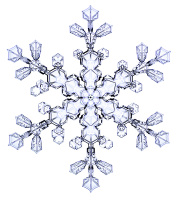 The
snowflake makes its first appearance in recorded history when people
identified individual snow crystals—with their distinctive six-fold
symmetry—as the constituent elements of falling snow. The earliest
known account was in 135 B.C., when Chinese scholar Han Yin wrote “Flowers of plants and trees are generally five-pointed, but those of snow, which are called ying, are always six-pointed.” The
snowflake makes its first appearance in recorded history when people
identified individual snow crystals—with their distinctive six-fold
symmetry—as the constituent elements of falling snow. The earliest
known account was in 135 B.C., when Chinese scholar Han Yin wrote “Flowers of plants and trees are generally five-pointed, but those of snow, which are called ying, are always six-pointed.”
Subsequent Chinese writers mentioned snowflake symmetry as well, an example being the 6th-century poet Hsiao Tung, who penned: “The ruddy clouds float in the four quarters of the cerulean sky. And the white snowflakes show forth their six-petaled flowers.” |
|  European authors began documenting snowflakes many centuries later; the first known reference was from Scandinavian bishop Olaus Magnus
in 1555. However, the clergyman described snowflakes as having a
peculiar assortment of shapes, including crescents, arrows, and even a
human hand (image on the right) so perhaps his account does not quite
warrant being called a historical first. European authors began documenting snowflakes many centuries later; the first known reference was from Scandinavian bishop Olaus Magnus
in 1555. However, the clergyman described snowflakes as having a
peculiar assortment of shapes, including crescents, arrows, and even a
human hand (image on the right) so perhaps his account does not quite
warrant being called a historical first.
English astronomer Thomas Harriot did a better job, correctly identifying the snowflake’s six-fold symmetry in 1591.
[Photo citation: eLibrary & Culture without Borders project; click here to see the source page.] |
| 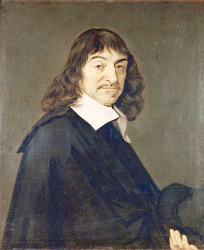 French philosopher and mathematician René Descartes
(shown in the oil painting on the left) recorded the
first detailed account of snow-crystal structure in 1637. In his
scientific study of meteorology and weather, Les Météores,
Descartes recorded some remarkably thorough naked-eye observations of
snow crystals, which included several of the rarer forms (see the Guide to Snowflakes page). This was the first time capped columns, for example, were recognized as a type of snow crystal. French philosopher and mathematician René Descartes
(shown in the oil painting on the left) recorded the
first detailed account of snow-crystal structure in 1637. In his
scientific study of meteorology and weather, Les Météores,
Descartes recorded some remarkably thorough naked-eye observations of
snow crystals, which included several of the rarer forms (see the Guide to Snowflakes page). This was the first time capped columns, for example, were recognized as a type of snow crystal.
|
| 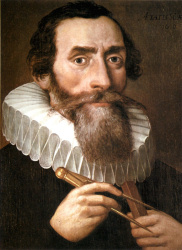 The first scientist to theorize about the six-fold symmetry of snow crystals was German scientist Johannes Kepler. In 1611, Kepler presented a small treatise entitled The Six-Cornered Snowflake
to his patron, Holy Roman Emperor Rudolf II, as a New-Year’s Day gift.
In his treatise, Kepler contrasted the six-fold symmetry of snowflakes
with similar symmetries found in flowers. He deduced that the
similarities must be in appearance only, since flowers are alive and
snowflakes are not: The first scientist to theorize about the six-fold symmetry of snow crystals was German scientist Johannes Kepler. In 1611, Kepler presented a small treatise entitled The Six-Cornered Snowflake
to his patron, Holy Roman Emperor Rudolf II, as a New-Year’s Day gift.
In his treatise, Kepler contrasted the six-fold symmetry of snowflakes
with similar symmetries found in flowers. He deduced that the
similarities must be in appearance only, since flowers are alive and
snowflakes are not:
Each
single plant has a single animating principle of its own, since each
instance of a plant exists separately, and there is no cause to wonder
that each should be equipped with its own peculiar shape. But to
imagine an individual soul for each and any starlet of snow is utterly
absurd, and therefore the shapes of snowflakes are by no means to be
deduced from the operation of soul in the same way as with plants.
Kepler
saw that a snowflake is really a relatively simple thing, made only
from ice, compared to the baffling complexity of life that is embodied
in a flower. He believed it could be fruitful, therefore, to
question what organizing principle was responsible for snow-crystal
symmetry. Since it was known that cannonballs display a hexagonal
pattern when stacked in a pile, Kepler conjectured that these two
symmetries might be related. There was a germ of truth in this
reasoning, since the geometry of stacking atoms lies at the heart of
snow-crystal symmetry. But the atomistic view of matter had not been
developed by Kepler’s time, so he could not carry the cannonball
analogy very far.
Kepler realized that the genesis of
crystalline symmetry was a worthy scientific question. He also
recognized the similarity between snow crystals and mineral crystals,
both exhibiting symmetrical faceted structures. But, at the end of his
treatise, Kepler accepted that the science of his day was not advanced
enough to explain it. He was certainly correct in this conclusion, for
three centuries would pass before scientists knew enough about atoms,
molecules, and their arrangement in solid materials to finally answer
Kepler’s 1611 query. (See the Snowflake Primer page.)
[Public domain image from Wikipedia]
|
| 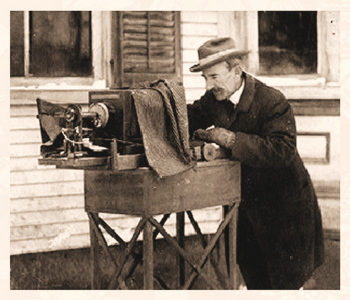 Wilson Bentley,
a farmer from the small town of Jericho, Vermont, created the first
photographic album of falling snow, which awakened the world to the
hidden wonders of snowflakes. Bentley became interested in the
microscopic structure of snow crystals as a teenager in the 1880s, and
he began experimenting with the new medium of photography as a means of
recording what he observed. He constructed an ingenious mechanism for
attaching a camera to his microscope for this purpose, and he succeeded
in photographing his first snow crystal in 1885, when he was nineteen
years old. Wilson Bentley,
a farmer from the small town of Jericho, Vermont, created the first
photographic album of falling snow, which awakened the world to the
hidden wonders of snowflakes. Bentley became interested in the
microscopic structure of snow crystals as a teenager in the 1880s, and
he began experimenting with the new medium of photography as a means of
recording what he observed. He constructed an ingenious mechanism for
attaching a camera to his microscope for this purpose, and he succeeded
in photographing his first snow crystal in 1885, when he was nineteen
years old.
To say Bentley was dedicated to snowflake
photography is an understatement. The winter pastime became his
lifelong passion, and in the course of forty-six years he captured more
than 5,000 snow-crystal images on glass photographic plates. He resided
his entire life in the same Jericho farmhouse, photographing snowflakes
each winter using the same equipment he constructed as a teenager.
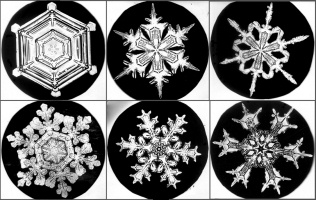 Bentley’s
photographs appeared in numerous publications over several decades,
providing for many their first look at the inner structure and symmetry
of snow crystals. And with thousands of snowflakes, all unique, the
world was exposed to their incredible variety as well. The now-familiar
old chestnut that no two snowflakes are exactly alike appears to have
had its origin in Bentley’s photographs. Bentley’s
photographs appeared in numerous publications over several decades,
providing for many their first look at the inner structure and symmetry
of snow crystals. And with thousands of snowflakes, all unique, the
world was exposed to their incredible variety as well. The now-familiar
old chestnut that no two snowflakes are exactly alike appears to have
had its origin in Bentley’s photographs.
In the late 1920s,
Bentley teamed with W. J. Humphreys, chief physicist for the United
States Weather Bureau, to author his magnum opus containing more than
2,000 snow-crystal photographs, entitled Snow Crystals..
The images on the right are from this book. Sadly, the 66-year-old
Vermont farmer died of pneumonia just a few weeks after the work was
published.
|
| 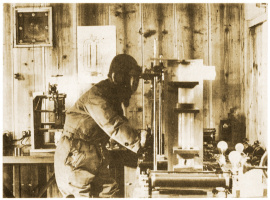 The snowflake story took a decidedly scientific turn in the 1930s, as Japanese physicist Ukichiro Nakaya
began the first laboratory investigation of snow crystals. While
earlier snowflake watchers had been limited to fairly basic
observations, Nakaya brought to bear the arsenal of new scientific
tools that had become available at the beginning of the twentieth
century. Following a substantial investigation of natural snowflakes,
Nakaya turned his attention to better understanding how these icy
structures were created in the clouds. As he had become a world expert
on winter precipitation, the scientist secured funding to build a
walk-in freezer laboratory at Hokkaido (northern Japan), exploiting the
recently invented technology of refrigeration. With this new facility,
Nakaya set out to create his own snowflakes for closer scrutiny and
study. The snowflake story took a decidedly scientific turn in the 1930s, as Japanese physicist Ukichiro Nakaya
began the first laboratory investigation of snow crystals. While
earlier snowflake watchers had been limited to fairly basic
observations, Nakaya brought to bear the arsenal of new scientific
tools that had become available at the beginning of the twentieth
century. Following a substantial investigation of natural snowflakes,
Nakaya turned his attention to better understanding how these icy
structures were created in the clouds. As he had become a world expert
on winter precipitation, the scientist secured funding to build a
walk-in freezer laboratory at Hokkaido (northern Japan), exploiting the
recently invented technology of refrigeration. With this new facility,
Nakaya set out to create his own snowflakes for closer scrutiny and
study.
Growing snow crystals in the laboratory turned out to be
a considerable challenge. Natural snowflakes float freely in the
atmosphere as they develop, and their long descent gives them ample
time to grow to a substantial size. Since a mile-high freezer was
clearly impractical, Nakaya needed a different approach to produce
crystals that were large enough to study.
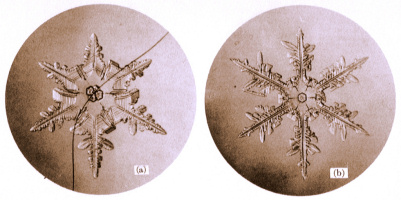 Nakaya
sought to suspend an individual snow crystal on a fine string, where he
could watch it grow and develop. That way the growth time could be
extended indefinitely. But here he hit a snag—he wanted an isolated
snow crystal, but what he got was a large numbers of tiny ice crystals
that coated his string with frost. Nakaya explored many different
filaments in his quest to make solitary snow crystals, including silk,
cotton, fine wires, and even a spider’s web. All resulted in frost-like
clusters of minute ice crystals. Nakaya
sought to suspend an individual snow crystal on a fine string, where he
could watch it grow and develop. That way the growth time could be
extended indefinitely. But here he hit a snag—he wanted an isolated
snow crystal, but what he got was a large numbers of tiny ice crystals
that coated his string with frost. Nakaya explored many different
filaments in his quest to make solitary snow crystals, including silk,
cotton, fine wires, and even a spider’s web. All resulted in frost-like
clusters of minute ice crystals.
Nakaya finally achieved
success in 1936 with, of all things, a rabbit hair. The natural
oils on the hair discouraged ice nucleation and prevented the growth of
large numbers of frost crystals. Instead, isolated snow crystals grew
into forms that bore an excellent resemblance to those produced in the
clouds. These were the world’s first synthetic snowflakes.
Our recent investigations making Designer Snowflakes and Electric Ice Needles were initially inspired by Nakaya's fascinating laboratory work. [Photos from the book Snow Crystals, by U. Nakaya, 1954.] |
| If you would like to read more about the history, science, art, and observation of snowflakes, you might enjoy my latest book: The Snowflake: Winter's Frozen Artistry |
|
|
|
